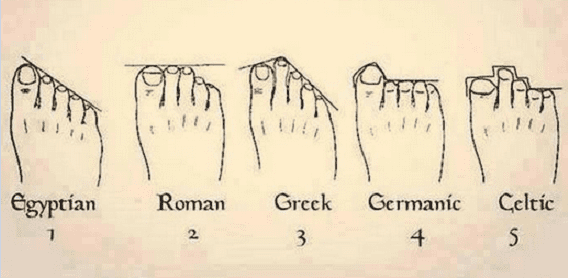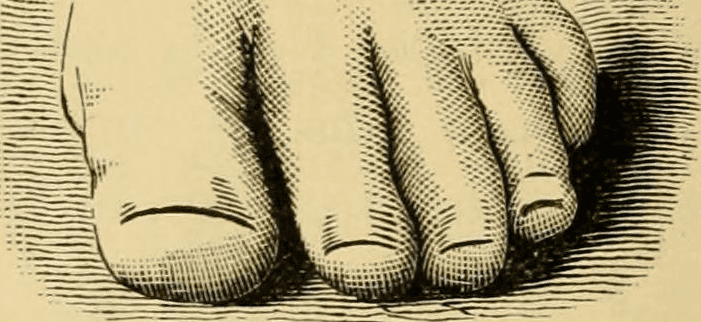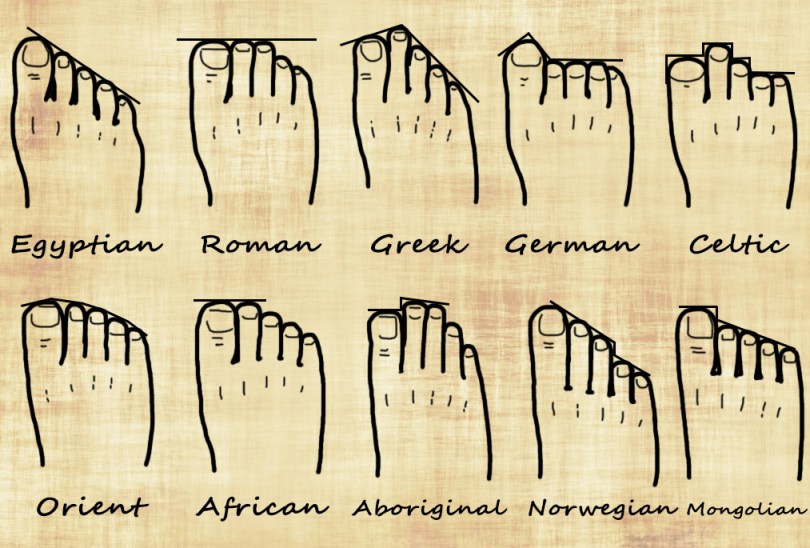Foot Shape Ancestry: What Your Toes Can Tell You
Tracing your family history has become easier with digitized records, including immigration documents, newspaper articles, passenger lists, and more. But have clues to your ancestry been hiding under your socks this whole time? As a premise, it seems far-fetched – but some believe the outline of your feet can help you trace your family heritage.
What can the shape of your foot or the length of your toes say about your ancestry? Is there a fundamental truth in phalanges? Let’s have a look.
The Premise of Foot Shape Ancestry
Foot and toe ancestry suggest that by looking at the shape of your feet, you can make an educated guess about the origins of your ancestors. This theory says there are essentially five major foot shapes: Egyptian, Roman, Greek, Germanic, and Celtic feet. Each group has a particular outline and arrangement of toe lengths, which hint at the population origin.

Celtic Feet
According to feet ancestry, Celtic feet have the most complex shape, with a large but short first toe, an exceptionally long second toe, and the remaining toes tapering to a small pinky. Celtic feet appear to be something of a combination of the Germanic and the Greek toe shapes, sharing the larger first toe of the German with the variety of lengths (especially in the case of the second toe) of the Greek.
Compare your toes to Celtic feet. Maybe you’ve got the luck of the Irish in you. Or maybe on closer inspection you’ve got a long first toe with all the others tapering down from there? In that case, you may have the so-called Egyptian foot.
But, can these archetypal shapes really tell us anything about our ancestry? What does science have to say about this idea?

Problems with Foot Shape Ancestry
It’s important to note that there is no scientific evidence that our feet conform to archetypal shapes, or that foot shape ancestry is an accurate way to trace your heritage. Data collected on multiple populations show a trend of their second toe being the longest (as seen with the Greek foot). For example, the Ainu people, an indigenous community in Japan, exhibit the second toe as the longest in 90% of individuals (an extreme example). However, it would be bizarre to think that the Ainu originated in Greece.
If we consider the claims of toe ancestry as a potential way to categorize an actual genetic group, then we need to look critically at the words used to describe the foot shapes. Why Egyptian, Roman, Greek, Germanic, and Celtic feet?

Where These Shapes Came From
Speaking primarily of the Egyptian, Greek, and Roman feet ancestry shapes, these are the idealized foot form in their respective culture’s art. For example, the Greek foot is one you can see on the statues that adorn the Acropolis (also the Statue of Liberty as it happens). While this may indicate that a majority of Greeks of that period had a foot shape like that one, it is much more likely that that was simply the standard of beauty at the time.
The Myth of “Original” Populations
Many modern ideas surrounding the concepts of “Germanness” and “Egyptianness” are just that: modern. The idea of an “ethnic German” was one essentially constructed in the 19th century when that area of Europe — traditionally divided into multiple different regions such as Prussia, Saxony, and Bavaria – was unified as the State of Germany. The “Germans” as the Romans knew them were a diverse mix of people and cultures. Romans called this group Germans because Rome saw them as barbarians and didn’t care to learn more about them.
The idea of foot shape ancestry and toe shape ancestry is rooted in a similar misconception that populations were ever made up entirely of one group. Human populations have migrated, fought, mixed and mingled throughout time. The idea that there was ever a monolithic population with Celtic feet is rooted in a grossly oversimplified version of how and where humanity has lived.
So, can you learn about your family origins from your foot shape? Possibly not. However, it is fun to have a look – and this idea could help inspire younger generations to learn more about their ancestors. source
You can oftentimes make a pretty good guess about a person’s heritage by looking at some of their physical features. Fair skin and red hair may lead you to believe a person is of Irish or Scottish descent, whereas a darker complexion could suggest a person has ancestors in the Mediterranean or Africa. Certain features tend to be more common among certain subgroups, and the same can sometimes be said about your feet. In today’s blog, we explain how you may be able to learn a little about your genealogy by looking at your feet and toes.
Your Feet And Your Family Tree
We came across this picture on Ancestral Findings, and although the foot shapes may be pretty generalizing in nature, these shapes tend to be slightly more common among these groups of people for a few different reasons. Genetics, evolution, and shoe styles all have influenced some of the foot shapes you’ll see below. But again, this is just a generalized view of certain foot patterns, is should not be seen as a surefire way to identify someone’s genealogy or heritage. That said, take a look at your feet. Do they match up with the picture below based on what you know about your ancestry? source
Can Your Foot Shape Reveal Your Personality or Your Ancestry? Learn More
With the proliferation of genealogy companies offering us a chance to discover more about our heritage through DNA analysis, our fascination with ancestry is growing.
MIT Technology Review reported that nearly 26 million Americans took at-home ancestry tests last year. Curiosity about the heritage in our DNA has lots of people asking questions about how ancestry shows up in the rest of the body.
Is there, for example, any truth to the idea that we can tell something about our ancestry by looking at our feet?
Ancestry websites contain archaic-looking charts with foot types labeled “Greek,” “Egyptian,” “Roman,” “Celtic,” and “Germanic.”
The charts suggest that the angle of your toes reveal the region from which your ancestors originated. Other websites declare that the shape of your feet can determine your personality type.

Does science support this idea? The answer is a clear no.
There’s no evidence to prove that ancestry determines the shape of your foot.
Human feet are highly individual. Your right foot and your left foot aren’t even identical. The angle of your toe descent or the length of your second toe doesn’t reveal either your heritage or your personality traits.
Keeping reading to learn more about differences in feet shape, and what the shape of your feet can reveal. Namely, the way you walk or run, and your potential risk for certain foot and leg conditions.
One of the most noticeable ways in which feet differ from person to person is the arch. What most of us call the arch — the medial longitudinal arch — is one of three arches in the foot:
- The medial longitudinal arch runs from the end of your heel to the ball of your foot, right down the center of your foot.
- The lateral longitudinal arch runs along the outside edge of your foot.
- The anterior transverse arch runs from side to side, just behind the ball of your foot.
The three arches work together to help your foot absorb shock and adapt to differences in terrain as you walk or run.
Your arch provides a lot of support for your body as you move through the day.
If your arch is either very high or flat, it could cause extra stress on your muscles and joints, especially if you’re involved in high-impact or endurance sports activities, or if you stand on your feet for long periods.
That’s because the height of your arch affects the way your foot moves. If your arch is too high or not high enough, it’s more likely that you’ll overuse certain parts of your foot, and overuse can lead to injuries.
Arches are usually characterized as either low or flat (pes planus), medium, or high (pes cavus).

To figure out which type of arch you have, doctors at the Mayo Clinic say you can try this simple test. Wet the bottom of your foot, then step on a piece of cardboard or construction paper.
If the wet print shows the entire bottom of your foot, it’s likely that you have low or flat arches. If you see about half of the middle section of your arch on the paper, you probably have arches that are medium, or more typical, in height.
And if you see just the imprint of your toes, your heel, and the ball of your foot on the paper, you probably have very high arches.
Pronation and supination refer to the side-to-side motions your foot carries out as you move. Pronation refers to an inward roll. If you look down at your foot as you take a step forward, you’ll see your ankle dip toward the inside arch just after your heel strikes the ground.
A certain amount of pronation is normal. When you take a step, your foot absorbs the shock by rolling slightly inward and downward.
Your arch flattens briefly, then your weight rolls to the outside of your foot and up toward the ball as you move forward. Then, you push off using your toes, with your big toe and second toe exerting most of the force.
A tiny amount of supination is also a normal part of walking or running. As you push forward, your foot naturally rolls toward its outside edge so it can redistribute the push-off pressure to your toes.

Too much of a good thing
Low arches commonly cause overpronation, while high arches typically cause oversupination. If your arch is very high, your foot might not pronate enough, which may mean too much of the push-off is being done by your small toes.
A 1994 study found that runners with very high arches absorb foot-pounding shocks poorly compared to runners with lower arches. Those biomechanical tendencies can eventually injure the ankle, iliotibial band, or Achilles tendons. The extra stress can also cause plantar fasciitis.
The shape of your foot — particularly your arch type — can cause you to develop certain conditions. These conditions usually develop as you age, or as physical activities put repeated stress on the bones and soft tissues in your feet.
Bunions
A bunion is a bony bump on the inside of your foot near the base of the big toe. Bunions are quite common. Around 23 percentTrusted Source of the population has them, and they’re particularly prevalent among older women.
Although bunions can be caused by nonhereditary factors, like wearing narrow, high-heeled shoes, researchers believe that having low arches or flat feet increases your risk of developing them.
Hammer toes
Hammer toe is the common name for severe bends in your second, third, fourth, or fifth toes. It’s a condition that usually develops as you age, and it can make finding comfortable shoes a real challenge.
Research indicates that both very high arches and flat feet both increase the odds that you’ll develop hammer toes. Both foot shapes make the muscles in your feet work in off-balance ways, which can change the forces at work on your toes over time.
Plantar fasciitis
Plantar fasciitis is an inflammation of the soft tissues that stretch from your toe to your heel. It usually causes sharp pains near your heel.
This condition has been associatedTrusted Source with high arches and oversupinated feet, as well as with low arches or flat feet.
Shin splints
If your foot posture is overpronated, you have a higher risk of developing medial tibial stress syndrome (MTSS), also known as shin splints, according to researchTrusted Source.
Shin splints cause pain that runs from your knee to your ankle on the front side of your leg, alongside your shinbone. Most of the time, shin splints happen in people who are active in stop-and-start athletic activities, like tennis or soccer.
Ankle injuries
If your foot chronically oversupinates or overpronates because of the structure of your foot, you may be more likely to injure your ankle, according to a 2001 studyTrusted Source. It may result in an ankle sprain, strain, or break.
StudiesTrusted Source show that if you have high arches, your ankle may not be as strong or well-supported as people with lower arches.
Hip, knee, or foot pain
StudiesTrusted Source have shown that the height of your arch — either pes cavus or pes planus — can cause pain in your lower extremities in addition to your feet. That’s because the way your feet move causes a ripple effect on the movements of your upper and lower legs. source



 Cops Gone Wild
Cops Gone Wild 
